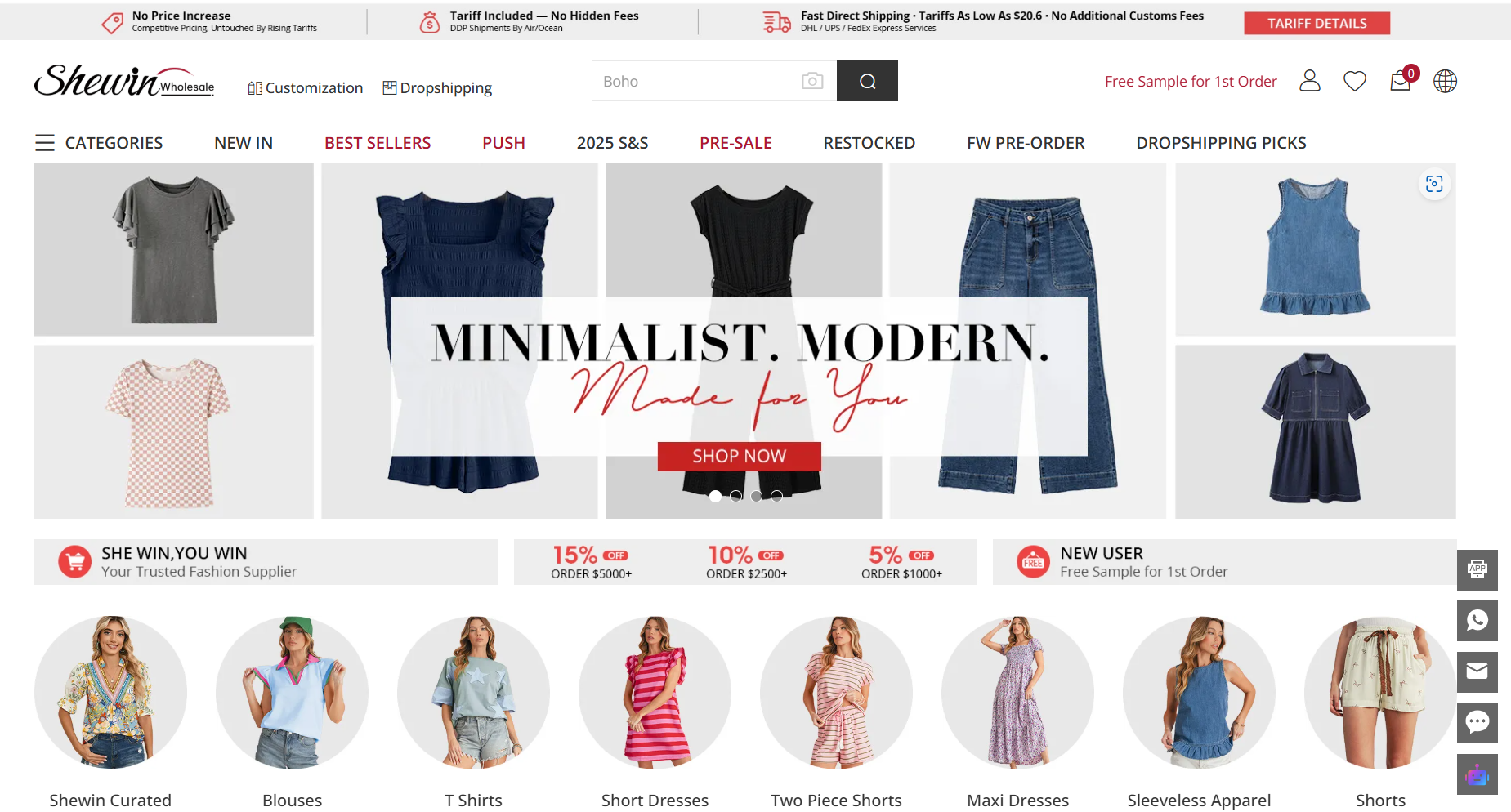
Discover the best places to buy clothes for your boutique. Explore sourcing options, including wholesale, dropshipping, and trade shows, for optimal success.
Starting a boutique is an exciting adventure. It’s hard to curate a personalized fashion collection, no matter what you’re dreaming of: a stylish online shop, a cozy brick-and-mortar storefront, or a hybrid of both.
But a well-thought-out sourcing strategy is essential for every successful boutique. If you’re in the early planning phase and asking yourself, “Where do boutique owners buy clothes?” You’re not alone.
In this article, you can explore different options for sourcing boutique clothing and key considerations to keep in mind. Also, we find out some tips on how to make your buying process efficient, profitable, and aligned with your brand.
Why Inventory Sourcing Matters
Clothes sourcing isn’t just about finding something to sell. It’s about aligning your inventory with:
- Your brand identity
- Your target customer
- Your price point
- And your logistical capabilities
The sourcing needs of a boutique that’s known for affordable trend pieces are quite different from one offering timeless luxury staples.
So, if you’re running a one-person online store, you don’t need to manage huge wholesale shipments you can’t store or afford.
That’s why it’s one of the first and most important steps to choose the right sourcing channels when starting your boutique.
4 Key Sourcing Options for Boutique Owners
There are four common ways to source clothes when launching a boutique. You can check out each one comes with its benefits, costs, and challenges. Now, let’s start.
1. Wholesale Vendors
This is the most traditional and widely used sourcing method in the boutique world.
With wholesale, you’re buying pre-made products in bulk from a vendor or manufacturer. The price is typically at 40–70% below the retail price.
You then mark up the price for your customers and keep the profit. Here are some benefits of working with wholesale vendors:
- Full control over your branding and packaging
- Better profit margins than dropshipping
- Ability to physically inspect products before shipping to customers
However, it usually comes with higher upfront costs and inventory risk.
Shewin is a popular platform among boutique owners for its affordable pricing, low minimum order quantities, and on-trend women’s fashion.

And the platform offers everything from dresses and tops to accessories and outerwear like wholesale denim jackets. So, with these benefits, it’s a good place to start.
2. Dropshipping Suppliers
Dropshipping allows you to sell products without holding inventory upfront. Instead, you ask the suppliers to ship the items directly to the customer when a customer places an order.
Here are its pros and cons:
Pros:
- No upfront costs
- No need for product storage
- Quick and low-risk testing of products
- Easier to enter
Cons:
- Less control over customization and branding
- Dependence on third-party stock availability
Dropshipping is perfect for beginners who want to test their concept before committing to larger inventory buys. Many boutique owners start with dropshipping and scale into wholesale once they have proven best-sellers.
And you can work with wholesale vendors, like Shewin, which offers both dropshipping and traditional wholesale options. It’s easy for you to test new products and switch models when you’re ready.
3. Trade Shows & Fashion Markets
If you’re near a major city like Los Angeles, New York, Atlanta, or Dallas, you can meet vendors in person and see collections up close at trade shows and fashion markets.
The following are the benefits and drawbacks of these trade shows:
Benefits:
- Exclusive lines not listed online
- Immediate product inspection
- Real-time relationship-building with vendors
Drawbacks:
- Travel expenses
- Not ideal for small or home-based startups
- Often requires wholesale licenses and credentials
While they’re great for research and networking, trade shows are often more helpful once you’ve already launched and know what your customers want.
4. Private Label & Custom Manufacturing
The private label option is best suited for boutique owners who want to create their own designs and build a distinct fashion brand.
Custom manufacturing allows you to design original products, add branded tags, packaging, and inserts, and build long-term brand recognition.
However, you should keep in mind that you may need to pay higher upfront costs, go through long development lead times, and face complex logistics and quality control problems.
If you’ve validated your product-market fit and you are ready to build a recognizable fashion brand from the ground up, custom and private label make sense.
What to Ask When Choosing a Clothing Supplier
Whether you’re going wholesale, dropshipping, or a hybrid of both, it’s essential to ask the right questions. Here is a list of questions you can ask before you choose the supplier.
- Are there sample orders available?
- What is the minimum order quantity (MOQ)?
- What is the average processing and shipping time?
- What’s the return and refund, or damage policy?
- Do they provide product photos and descriptions?
- Is branding or private labeling supported?
After getting answers to these questions, you can vet which supplier meets your needs well. Also, you should take your long-term goal into consideration before you make the final decision.
Sourcing Tips for New Boutique Owners
Now, if you have already found the best supplier(s) to work with, here are some sourcing tips you should keep in mind before you start.
Market Research
The first thing is to know your ideal customer. You can learn if they are price-conscious trendsetters or minimalists looking for quality basics through market research. Let your customer profile guide your buying decisions.
Buy Small, Test Often
The next tip is to buy small samples but test often. It’s better to start with fewer pieces across more styles than to over-invest in one product category. You should test what works, then reorder based on data.
Keep Up with Trends
The third thing is to follow up on the trends. Wholesale vendors constantly update their catalogs. It’s better to stay updated by browsing trending categories that will be popular.
Diversify Sourcing
The last thing is that you should not rely on a single supplier. While they’ve proven reliable over time, you may meet problems in the long-term run. You can protect your brand in case of shipping delays or stock outages by having backup options.
Find Resources to Help
If you’re still feeling unsure about where to start. Fortunately, some suppliers offer guides to help you understand where to buy clothes in bulk, what to look out for, and how to stay profitable. You can learn from them to get started.
Final Thoughts
Launching a boutique is one part passion and one part strategy. Sourcing is where those two meet. You want styles that excite your customers, but you also need prices and processes that support your bottom line.
Whether you choose to dropship, buy wholesale, or explore private labeling, the key is to stay curious, test thoughtfully, and grow with intention.
So go ahead and curate your dream collection. Your boutique deserves it.
Was this news helpful?







 Yes, great stuff!
Yes, great stuff! I’m not sure
I’m not sure No, doesn’t relate
No, doesn’t relate



